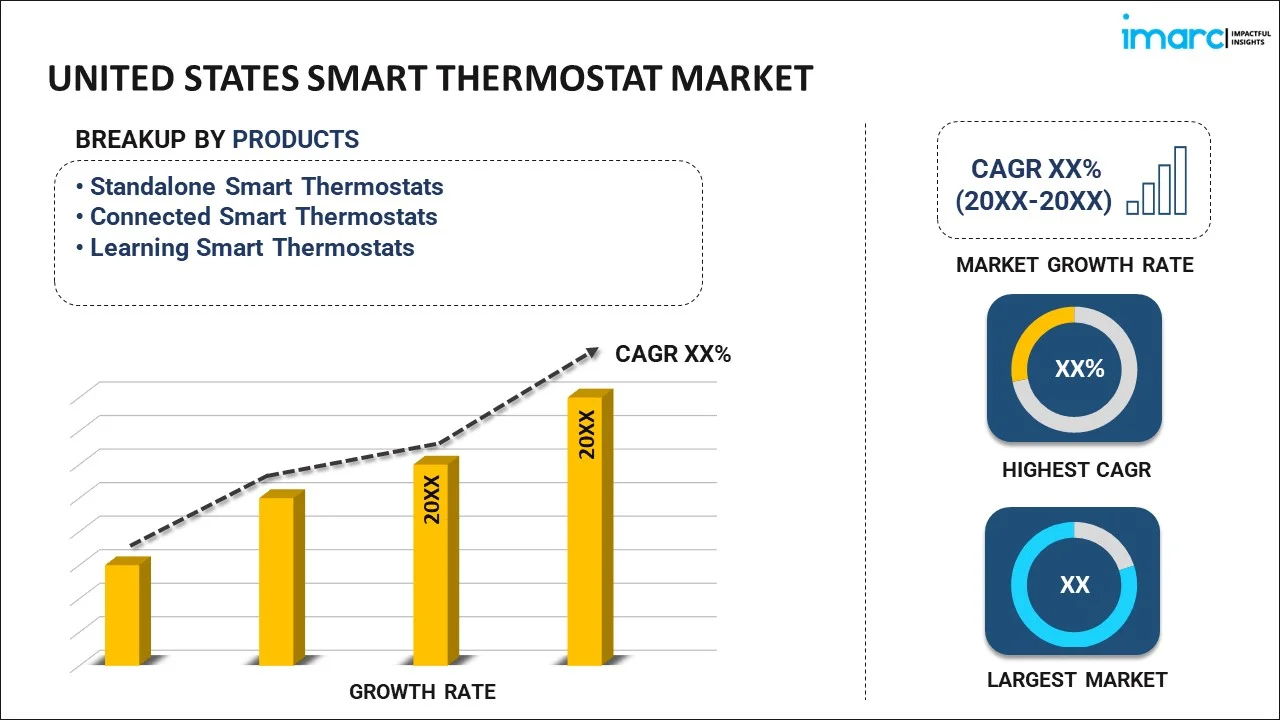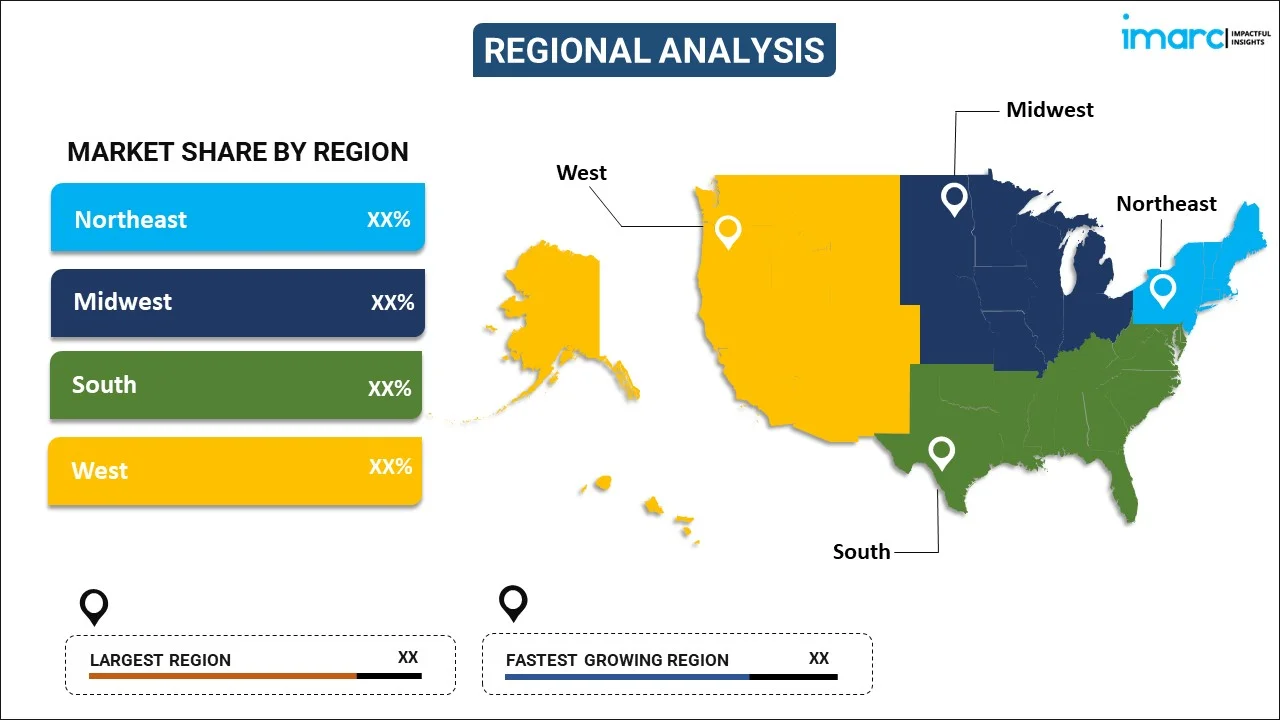
United States Smart Thermostat Market Report by Product (Standalone Smart Thermostats, Connected Smart Thermostats, Learning Smart Thermostats), Component (Display, Temperature Sensors, Humidity Sensors, Motion Sensors, and Others), Technology (Wired, Wireless), Application (Residential, Commercial, Industrial), and Region 2025-2033
Market Overview:
United States smart thermostat market size reached USD 1,036.6 Million in 2024. Looking forward, IMARC Group expects the market to reach USD 4,132.1 Million by 2033, exhibiting a growth rate (CAGR) of 16.6% during 2025-2033. The increasing awareness of energy efficiency, growing popularity of smart homes, recent advancements in machine learning (ML) and artificial intelligence (AI), and the introduction of favorable government incentives and rebates represent some of the key factors driving the market.
|
Report Attribute
|
Key Statistics
|
|---|---|
|
Base Year
|
2024 |
|
Forecast Years
|
2025-2033
|
|
Historical Years
|
2019-2024
|
| Market Size in 2024 | USD 1,036.6 Million |
| Market Forecast in 2033 | USD 4,132.1 Million |
| Market Growth Rate (2025-2033) | 16.6% |
A smart thermostat refers to an advanced technology designed to regulate temperature within a living space or office environment. They are categorized into Wi-Fi, Zigbee, Z-Wave, and others, each offering unique connectivity features. Smart thermostats comprise several components, such as temperature sensors, motion sensors, humidity sensors, and processors. They are constructed using robust materials like plastics, metals, and advanced composites. The manufacturing process of smart thermostats involves sophisticated assembly lines with precision engineering to ensure reliability and efficiency. They find applications in diverse areas, including residential homes, commercial buildings, educational institutions, healthcare facilities, retail spaces, industrial units, hospitality venues, government buildings, transportation systems, and smart city projects. Smart thermostats are known for their energy savings, cost-effectiveness, convenience, remote accessibility, enhanced comfort, user-friendly interfaces, compatibility with smart home systems, real-time data analysis, and environmental sustainability. In addition, they provide several advantages, such as reduced carbon footprint, adaptability to changing weather conditions, learning capabilities, integration with other smart devices, customizable settings, occupancy detection, voice control compatibility, programmable features, and usage tracking for better energy management.
United States Smart Thermostat Market Trends:
The increasing awareness of energy efficiency and the need to reduce utility bills in the United States is propelling the market growth. Additionally, the growing popularity of smart homes and the integration of the Internet of Things (IoT) devices are acting as another growth-inducing factor. Besides this, recent advancements in machine learning (ML) and artificial intelligence (AI) technology, which have made smart thermostats more intuitive and user-friendly, attracting a broader consumer base, are positively influencing the market growth. Furthermore, the introduction of favorable government incentives and rebates for adopting energy-efficient devices is catalyzing the market growth. In addition, the surge in new construction activities, both residential and commercial, which incorporate smart thermostats as a standard feature, is driving the market growth. Apart from this, the rising environmental concerns and the push for sustainable living practices, prompting consumers to adopt energy-saving devices like smart thermostats, are strengthening the market growth. Moreover, the rapid proliferation of high-speed internet and the widespread adoption of smartphones, which facilitate the remote control and monitoring of smart thermostats, are supporting the market growth. Along with this, the increasing investment in smart city projects across the United States, which includes the integration of smart thermostats for energy management, is providing a considerable boost to the market growth. Additionally, the escalating collaborations between energy providers and smart thermostat manufacturers, offering consumers cost-effective solutions, are fueling the market growth.
United States Smart Thermostat Market Segmentation:
IMARC Group provides an analysis of the key trends in each segment of the market, along with forecasts at the country level for 2025-2033. Our report has categorized the market based on product, component, technology, and application.
Product Insights:

- Standalone Smart Thermostats
- Connected Smart Thermostats
- Learning Smart Thermostats
The report has provided a detailed breakup and analysis of the market based on the product. This includes standalone smart thermostats, connected smart thermostats, and learning smart thermostats.
Component Insights:
- Display
- Temperature Sensors
- Humidity Sensors
- Motion Sensors
- Others
A detailed breakup and analysis of the market based on component have also been provided in the report. This includes display, temperature sensors, humidity sensors, motion sensors, and others.
Technology Insights:
- Wired
- Wireless
- WiFi
- Zig Bee
- Others
The report has provided a detailed breakup and analysis of the market based on the technology. This includes wired and wireless (wifi, zig bee, and others).
Application Insights:
- Residential
- Commercial
- Industrial
A detailed breakup and analysis of the market based on application have also been provided in the report. This includes residential, commercial, and industrial.
Regional Insights:

- Northeast
- Midwest
- South
- West
The report has also provided a comprehensive analysis of all the major regional markets, which include the Northeast, Midwest, South, and West.
Competitive Landscape:
The market research report has also provided a comprehensive analysis of the competitive landscape in the market. Competitive analysis such as market structure, key player positioning, top winning strategies, competitive dashboard, and company evaluation quadrant has been covered in the report. Also, detailed profiles of all major companies have been provided.
United States Smart Thermostat Market Report Coverage:
| Report Features | Details |
|---|---|
| Base Year of the Analysis | 2024 |
| Historical Period | 2019-2024 |
| Forecast Period | 2025-2033 |
| Units | Million USD |
| Scope of the Report | Exploration of Historical Trends and Market Outlook, Industry Catalysts and Challenges, Segment-Wise Historical and Future Market Assessment:
|
| Products Covered | Standalone Smart Thermostats, Connected Smart Thermostats, Learning Smart Thermostats |
| Components Covered | Display, Temperature Sensors, Humidity Sensors, Motion Sensors, Others |
| Technologies Covered |
|
| Applications Covered | Residential, Commercial, Industrial |
| Regions Covered | Northeast, Midwest, South, West |
| Customization Scope | 10% Free Customization |
| Post-Sale Analyst Support | 10-12 Weeks |
| Delivery Format | PDF and Excel through Email (We can also provide the editable version of the report in PPT/Word format on special request) |
Key Questions Answered in This Report:
- How has the United States smart thermostat market performed so far and how will it perform in the coming years?
- What has been the impact of COVID-19 on the United States smart thermostat market?
- What is the breakup of the United States smart thermostat market on the basis of product?
- What is the breakup of the United States smart thermostat market on the basis of component?
- What is the breakup of the United States smart thermostat market on the basis of technology?
- What is the breakup of the United States smart thermostat market on the basis of application?
- What are the various stages in the value chain of the United States smart thermostat market?
- What are the key driving factors and challenges in the United States smart thermostat?
- What is the structure of the United States smart thermostat market and who are the key players?
- What is the degree of competition in the United States smart thermostat market?
Key Benefits for Stakeholders:
- IMARC’s industry report offers a comprehensive quantitative analysis of various market segments, historical and current market trends, market forecasts, and dynamics of the United States smart thermostat market from 2019-2033.
- The research report provides the latest information on the market drivers, challenges, and opportunities in the United States smart thermostat market.
- Porter's five forces analysis assist stakeholders in assessing the impact of new entrants, competitive rivalry, supplier power, buyer power, and the threat of substitution. It helps stakeholders to analyze the level of competition within the United States smart thermostat industry and its attractiveness.
- A competitive landscape allows stakeholders to understand their competitive environment and provides an insight into the current positions of key players in the market.
Need more help?
- Speak to our experienced analysts for insights on the current market scenarios.
- Include additional segments and countries to customize the report as per your requirement.
- Gain an unparalleled competitive advantage in your domain by understanding how to utilize the report and positively impacting your operations and revenue.
- For further assistance, please connect with our analysts.
 Inquire Before Buying
Inquire Before Buying
 Speak to an Analyst
Speak to an Analyst
 Request Brochure
Request Brochure
 Request Customization
Request Customization




.webp)




.webp)












